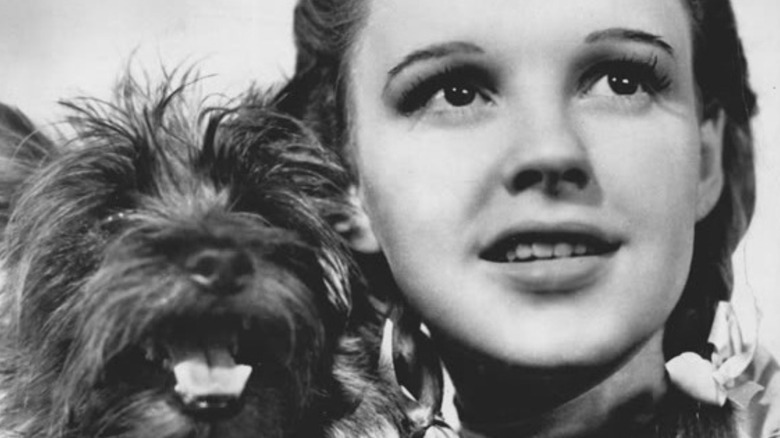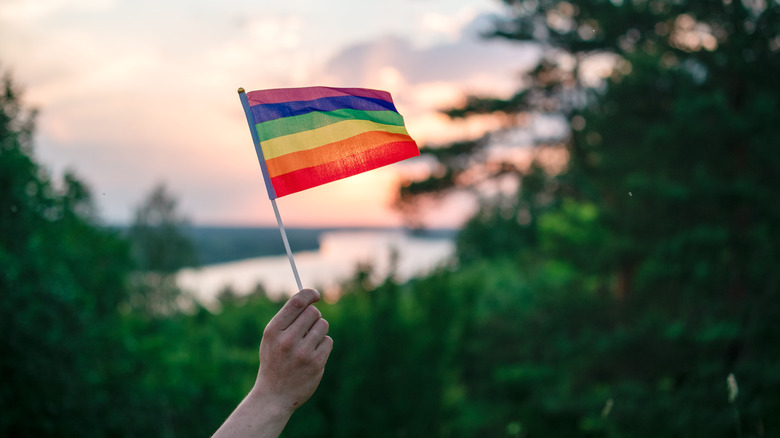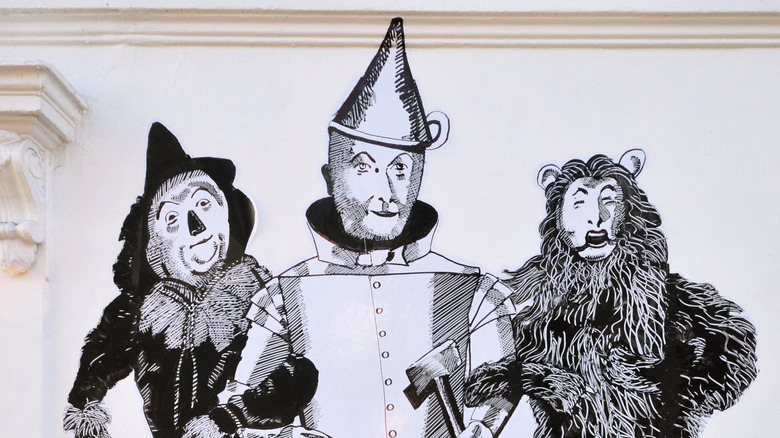How Judy Garland In The Wizard Of Oz Became A Symbol Of Hope For The LGBTQ+ Community
Judy Garland has been a gay icon for several generations. According to PBS' "American Masters," a 1967 article from the gay newspaper The Advocate proclaimed her "the Elvis of homosexuals," and Time magazine went so far as to have a team of psychologists discuss possible reasons for Garland's particular popularity among gay men. The term "friends of Dorothy" became a slang term with which gay men could subtly refer to one another, which soon caught on as a popular phrase outside of the LGBTQ+ communities as well. Why did the phrase specifically highlight the wide-eyed, adventurous child from "The Wizard of Oz," Dorothy Gale, played by Garland when she was just 16 years old?
One theory revolves around "The Wizard of Oz" as a whole as an important touchstone within the gay community. In a 2016 article from Cleveland, Ohio's The Plain Dealer, writer Michael Heaton noted that several components of the film have led some to suggest that it lends itself to being an allegory for gay life in the United States, including the Scarecrow's line about the Yellow Brick Road in which some people go one way, some go another, and "some people go both ways." The Cowardly Lion calls himself "a dandy lion" and Glinda the Good Witch exhorts the Munchkins "come out, come out, wherever you are." The Wizard hides his true self behind a curtain for most of the movie, and within the Emerald City is a "horse of a different color," which describes a being who is different from others.
The Wizard of Oz without Over the Rainbow?
"Somewhere Over The Rainbow" is famously sung by Garland as Dorothy in "The Wizard of Oz." The song became one of her signature pieces and a favorite among her fans. It's hard to imagine both the movie and the rest of Garland's career without "Somewhere Over The Rainbow," but according to Marilyn Malara (via United Press International), the song was very nearly cut from the film. Producers thought the movie's running time was too long and realized cutting the song would bring its run time under 100 minutes. Associate producer Arthur Freed is thought to have insisted on keeping the song and ensuring its place in musical, cinematic, and, ultimately, gay history. Per The Atlantic, a 1967 review of a Garland concert at New York's Palace Theatre noted that "A disproportionate part of her nightly claque seems to be homosexual" and observed that some concertgoers "practically levitate from their seats, particularly when Judy sings ['Over the Rainbow']."
Just over a decade after this review, according to Slate, San Francisco artist Gilbert Baker designed what is thought to be the original rainbow flag, which was adopted as a symbol of pride by the LGBTQ+ community. Baker used each color symbolically: pink for sex, red for life, orange for healing, yellow for sunlight, green for nature, blue for art, indigo for harmony, and violet for the human spirit. (The pink and indigo were later dropped and the six colors remain the standard.)
The significance of Dorothy's journey
Per Slate, Gilbert Baker probably didn't take direct inspiration from "Somewhere Over The Rainbow" in creating the rainbow flag, but many think it's likely that the symbol caught on so dramatically within the LGBTQ+ community in part because of the popularity and significance of Judy Garland and her signature song among some of its members. In 1994, The New York Times examined "The Wizard of Oz" and its importance to some gay men and reported that some people used the phrase "I have the feeling we're not in Kansas anymore" upon visiting a gay bar for the first time, and made comparisons between Dorothy's journey from her home in rural Kansas to the colorful, exciting Oz to the actual and metaphorical journeys undertaken by members of the LGBTQ+ seeking self-discovery while longing for a sense of home.
As for the phrase "friend of Dorothy," the origin of the term in unclear. According to writer Dee Michel, author of the book "Friends of Dorothy: Why Gay Boys and Gay Men Love 'The Wizard of Oz'," among the reasons some gay men love "The Wizard of Oz" and the character of Dorothy is the fact that she is friends with the Scarecrow, the Tin Man, and the Cowardly Lion, none of whom present as stereotypically masculine, and the group bands together as a chosen family, as do many in the LGBTQ+ community. Michel surveyed a variety of primary sources published between 1941 and 2006, none of which listed or defined the term, making its history all the more difficult to trace.


